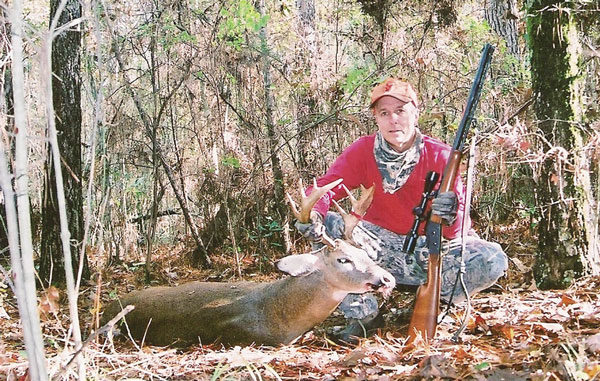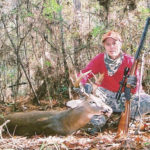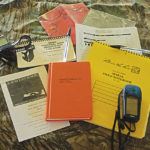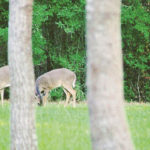
This retired deer biologist has remarkable success because he writes down his observations from every hunt.
A 30-minute deer hunting show on the Outdoor Channel probably shows about 15 minutes of the hunt and the rest of the time is spent promoting products that the hunters are using to bag this trophy whitetail.
Thumb through any magazine that features deer hunting, and there will be lots of ads promoting products that will either grow bigger deer or turn you into a super deer hunter like Natty Bumpo.
Do these products really work?
There really is not a good answer — what works for someone in an area may not produce the same results for another hunter in a different area. Trial and experimentation will aid in determining their value. Recording and documenting results are part of the trial and experimentation procedure. Once the hunt is over, we often forget the fine details that made the hunt successful, or made it just one big fiasco.
For several years, I have been documenting my hunts in a field book during my many adventures in the great outdoors. Keeping a hunting journal is really nothing new. If you have not read the Journal of Lewis and Clark you need to put that on your list of things to do during the offseason. Throughout history, early explorers kept notes of their travels and recorded their findings in a journal.
It is interesting to see the changes that have occurred in the wildlife populations in our western states that Lewis and Clark originally observed. The Louisiana State Archives office in Baton Rouge has documents concerning the wildlife populations that the early explorers and settlers found in the state.
One document records the daily kill of game on Lovelace Plantation; the entries include a brief statement about the weather and what work was being done along with the harvest of pigeons, ducks and deer as well as catching raccoons and oppossums. One entry states that Tommy killed a fine buck in the morning while another entry records that the writer shot at a deer, it bled, but they could not find it.
Keeping notes of the hunt and what goes on during the course of the day may aid in having success from one year to the next. Part of the documentation process is keeping maps of where the action is taking place.
When hunting on Pearl River WMA, I am always looking for an oak tree that was spared from Katrina. Last year I found a good cow oak that was in the middle of briar thicket that had produced some acorns and was attracting deer and hogs. Having documented the tree in the journal and on my map, I can now remember to visit this site during the early hunts this year and see if it produced acorns again.
Information that can be recorded includes weather conditions, trails, feeding areas with associated sign, communication activities of deer (rubs and scrapes), rut schedule and moon phase.
The more that can be documented, the better the data set. The data bank will help in taking some of the luck out of deer hunting. Why did that buck respond to the grunt call? Perhaps it was the phase of the rut and the animal’s physiology was right; maybe it was the weather conditions that put the buck on the move. Being able to review the conditions of the hunt will help provide insight that will aid you in future hunts.
Many biologists recommend that hunters keep deer-observation logs. Such logs usually record the number of deer seen (antlered bucks, does and fawns) along with the number of hours hunted. The date of the hunt and the time deer were seen is also recorded. These observations can be compared with other biological information and habitat data to aid in determining deer-herd density, deer reproduction, etc.
If your club collects reproductive tracts from does and this information indicates that the adult does should be producing two fawns, the observations should support and document the reproduction. If the observations indicate that most adult does only have one fawn, something is going on between breeding, fawning and fawn-raising time that has reduced your reproduction rate.
LDWF deer biologist Scott Durham has a deer observation survey log that he provides to clubs and landowners. Primarily, this survey is geared toward bowhunters since one of the survey’s goals is to determine the fawn-to-doe ratio. This is best done at the time when fawns are small and there is a distinct size difference.
In Areas 1 and 6, many of the fawns still have spots in October, so this makes it quite obvious. As the fawns grow, it becomes more difficult in the late season to distinguish between fawns, yearlings and adults. This survey is important to the biologist who is also doing browse surveys and herd-health collections on the property; the survey further aids in determining the estimated population and reproductive rate of the herd.
Last year on the Sugarland Hunting Club in Pointe Coupee Parish, I assisted club members with the collection of reproductive tracts from adult does. Based upon the findings, most adult does should be producing twins this summer. Using this deer observation survey, the club members could verify this quite easily. It should be noted that this club is in Upper Area 6, where the breeding occurs late — January and February are the peak months. No breeding activity (ovulation) was noted until around Jan. 10.
This documented fact alone will help club members in establishing their vacation time for the deer season. No need to use it up during the early days in November and December; the rut activity doesn’t start until late December, and it was obvious from the harvest dates that when the rut kicks in, the deer movement is good and hunting is productive.
If the observations by the club indicate that most does indeed do have twins, then reproduction can be considered good and would indicate the population is healthy. On the other hand, if club members are seeing does with only one fawn, then based upon the ovulation data, something is happening that is holding down productivity. Habitat conditions and predation would be two areas to investigate.
Predation of fawns by coyotes has been in the spotlight for several years in the southeast. Coyote predation is reduced if the habitat conditions are such that there is good escape cover for the fawns.
During a typical hunt, I record the general weather conditions (wind, rain, etc.), moon phase, along with the animal observations. I document the temperature and barometric pressure every hour using an atmospheric data center meter. The particular instrument I use is made by Brunton, although there are several companies that make them. This instrument is not cheap, but it has been a good investment and keeps me on the stand if the conditions indicate deer should be moving.
Deer-activity observations include the time deer were seen, feeding activities, rub and scrape activity, new deer trails, response of animals to calls and any other animal activity that I find interesting. When hunting a WMA, I am always on the lookout for new hog sign, wallows, droppings and rootings.
I always document the appearance of rubs and scrapes. Scrape initiation occurs during the pre-rut period, and generally about one month later, the first peak of scrape activity occurs. Scrape initiation is that time when those annual scrape sites (ones used every year) are first opened up.
Hunting scrapes during scrape initiation is not very productive, but knowing when the first peak of scraping will occur and hunting scrapes at that time has worked for me. Always keep in mind that more than one buck as well as does will be working scrapes. When I find that scrapes are being worked every day, I know that my best chance for success is now, especially if the weather conditions are right.
If you are a hunter who can only hunt on weekends, scrape hunting probably will not work for you. Scrapes are part of the communication world of the deer, and when the communication is taking place every day, it is time to hunt. Deer are most active in the early mornings and late evenings, and when hunting a scrape, I like to be in the stand well before daylight.
Weather conditions have an impact on success and a review of past seasons data (dates, temperature, barometric pressure, rut activity) has helped me to be successful. One good piece of advice is to pay attention to the barometric pressure.
I often hear people say that they’re going to hunt whenever they can. After years of wasting time, energy and gas on hunts when conditions were not good, I am pretty much resolved to only hunt when the time is right and take care of other issues and chores when the time is not right.
Over the past three seasons, I have killed seven adult bucks, 3½ years and older, and I can say that my success is due to hunting during the times when deer activity is high, based upon the data that I have collected over the years. Of course it helps to be retired and to be able to hunt when the time gets right.
What do I focus on? The best deer activity occurs during the breeding season. In Area 2, when the deer season opens for gun hunting, the rut is taking place, so hunters need to be out there for the opening days. In portions of Areas 1 and 6, where the rut is late, being there when the season opens in November is not that important. Hunters have it in their minds that they need to be out there for opening day, or they will miss out, but when the rut doesn’t come until late December, November hunting really is a waste of vacation time.
I will hunt the best days of the first peak of the breeding season. If the weather is cold and the barometric pressure is above 30.0, I will hunt the pre-rut in my area in November. Based on my data set, however, the majority of the adult bucks that I see and kill are in December and January. The largest bucks I have seen the last three years have been during the second peak of our rut in January.
Most of the does are bred during the first peak of the rut, and it is fairly easy for a buck to find a willing doe. During the second peak, the competition is high for these few remaining does, and buck movement is good along with their scraping and rubbing activities. If you use up all your hunting days and don’t hunt the second peak, you are missing out on some very good hunting. The rut is the time when all the deer accessories, calls, rattling antlers and scents have the best chance to work, so do not hesitate to try them.
I always document the success or lack of success whenever I try the various accessories available to hunters. Over the years, I have found that does respond to fawn bleats during the early season, but as the season gets late and fawns have been weaned, they aren’t interested.
Grunt calls can work at anytime; it seems that the key is the physiology of the deer hearing it. If it is interested, it will come investigate, if not, it goes on about its business.
I generally have not had much success with deer scents. This past season I did try the C’Mere Deer attractant, and on three occasions had young deer come right to the spot where it was sprayed.
Rattling antlers work best prior to the rut chasing, but like the calls, the success depends on the physiology of the buck, but it doesn’t stop me from using them.
If there is a good acorn crop I depend on that as the feed source to hunt around. Rice bran does work in the early season, but in the Clinton area I don’t see much use after November.
Once the acorns are gone, deer use of corn goes up.
My field notes are taken in the all-weather (write-in-the-rain) books that are available from places like Forestry Supply in Jackson, Miss., or Construction Safety Products in Shreveport.
Data should be collected on all harvested deer, even if you are not involved in a deer-management program. This information provides solid evidence of the growth and development of the deer herd. Biologists with LDWF will be glad to assist you, even if you don’t become involved with one of their management programs. Deer-data collection records and the tools necessary to collect this data are also available from Forestry Supply, Construction Safety Products and from the Quality Deer Management Association.
This season when you hit the woods, take a notebook and pen and document your hunt. Who knows? You may just find that one ingredient that guarantees success every time. At least it will give you something to do when you are in the stand.





